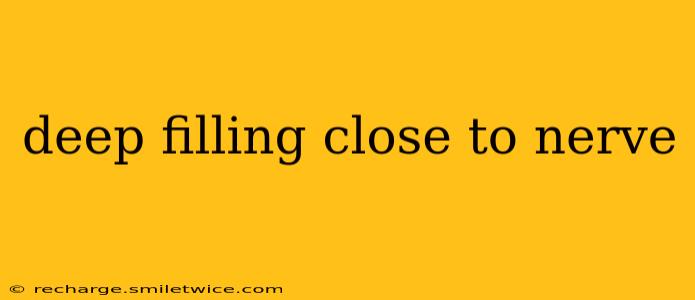A deep cavity that's close to the nerve in your tooth can be a cause for concern. The process of receiving a deep filling near the nerve is a common dental procedure, but it's crucial to understand the potential risks and what to expect. This article will address common questions and concerns surrounding deep fillings and proximity to the nerve.
What Happens if a Filling Gets Too Close to the Nerve?
When a cavity extends close to the dental pulp (the nerve), there's a risk of irritation or inflammation. This can lead to pain, sensitivity to hot and cold temperatures, and even a toothache. The severity depends on how close the filling is to the nerve and the individual's sensitivity. In some cases, the dentist may need to take additional measures to protect the nerve, such as placing a protective liner or base before the filling. In severe cases, a root canal might be necessary.
How Can Dentists Avoid Damaging the Nerve During a Deep Filling?
Modern dentistry employs various techniques and technologies to minimize the risk of nerve damage during deep fillings. These include:
- Digital X-rays: Provide a clear image of the tooth's structure, helping the dentist accurately assess the cavity's depth and proximity to the nerve.
- Electric Pulp Testing: This test measures the tooth's response to electrical stimuli, helping dentists determine the health of the nerve.
- Rubber Dam Isolation: This technique isolates the tooth from saliva and bacteria, maintaining a clean and dry field for the procedure.
- Careful Excavation: Dentists carefully remove decayed tooth structure, minimizing trauma to the surrounding healthy tissue.
- Protective Liners and Bases: These materials act as a barrier between the filling material and the nerve, providing insulation and protection.
Can a Deep Filling Cause Nerve Damage?
While rare with proper technique, there's a possibility of nerve damage during a deep filling procedure. This is more likely if the cavity is extremely deep, if the dentist isn't careful, or if the patient's anatomy is particularly challenging. However, skilled dentists use the techniques mentioned above to significantly reduce this risk. Signs of potential nerve damage include persistent pain, increased sensitivity, and swelling. If you experience any of these symptoms after a filling, contact your dentist immediately.
What are the Symptoms of a Deep Filling Getting Too Close to the Nerve?
Symptoms indicating a deep filling is impacting the nerve can vary but often include:
- Sharp, shooting pains: Especially when biting down or consuming hot or cold food and drinks.
- Lingering sensitivity: The pain doesn't immediately subside after removing the stimulus.
- Spontaneous pain: Pain occurs without any apparent trigger.
- Swelling or inflammation: In the gums surrounding the affected tooth.
If you experience these symptoms, it's vital to consult your dentist promptly. Early intervention can often prevent more serious complications.
How Long Does it Take for a Deep Filling to Settle?
The time it takes for a deep filling to settle varies, depending on the depth of the cavity and the individual's healing response. Most patients experience some sensitivity in the initial days or weeks following the procedure, but this typically subsides. If the sensitivity persists or worsens, it's crucial to seek your dentist's advice.
Does a Deep Filling Always Need a Root Canal?
No, a deep filling doesn't always necessitate a root canal. A root canal is only required if the nerve is irreversibly damaged or infected. With proper care and techniques, many deep fillings can be successfully placed without requiring further procedures. Your dentist will assess the situation and determine the best course of action.
Disclaimer: This article provides general information and should not be considered medical advice. Consult with your dentist for any concerns regarding deep fillings or dental procedures.
